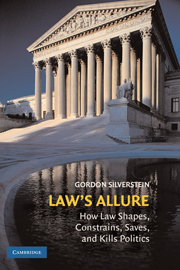Book contents
- Frontmatter
- Contents
- Acknowledgments
- LAW'S ALLURE
- Introduction: Law's Allure: The Juridification of American Politics and Public Policy
- PART I LAW'S ALLURE: WHY, WHY NOW, AND WHY IT MATTERS
- 1 Motives, Incentives, Patterns, and Process
- 2 Why Now? From May and May Not – To Must
- 3 Law Is Different: The Power of Precedent
- PART II LAW'S ALLURE: PATTERNS, PROCESS, AND CAUTIONARY TALES
- PART III LAW'S ALLURE: COSTS AND CONSEQUENCES
- Conclusion: The Promise and Peril of Law's Allure
- Bibliography
- Index
- References
1 - Motives, Incentives, Patterns, and Process
Published online by Cambridge University Press: 05 June 2012
- Frontmatter
- Contents
- Acknowledgments
- LAW'S ALLURE
- Introduction: Law's Allure: The Juridification of American Politics and Public Policy
- PART I LAW'S ALLURE: WHY, WHY NOW, AND WHY IT MATTERS
- 1 Motives, Incentives, Patterns, and Process
- 2 Why Now? From May and May Not – To Must
- 3 Law Is Different: The Power of Precedent
- PART II LAW'S ALLURE: PATTERNS, PROCESS, AND CAUTIONARY TALES
- PART III LAW'S ALLURE: COSTS AND CONSEQUENCES
- Conclusion: The Promise and Peril of Law's Allure
- Bibliography
- Index
- References
Summary
Turning to the courts, relying on judicial decision making, and formalizing, proceduralizing, and automating the political process as substitutes or replacements for the traditional methods of politics – organizing, electioneering, negotiating, and bargaining – can shape, frame, and constrain policy choices and politics itself. But when are these risks higher or lower? When are they more or less tolerable?
Juridification is not an all-or-nothing proposition. It is a continuum. At one extreme, policy entrepreneurs and elected officials might come to rely on the courts and judicial decisions to define and impose, block, or redirect policy preferences – although, even at this extreme, administrative procedures and statutory provisions will still be needed to apply and enforce these rulings. At the other end of the spectrum, policy is debated, negotiated, approved, and implemented through the ordinary legislative and administrative channels – although, even at this extreme, individual cases will arise in which courts will be asked to interpret and apply these laws and administrative rulings.
The relative risks (and rewards) of juridification need to be evaluated along two primary dimensions: (1) the motives and incentives that might lead politicians, policy entrepreneurs, litigators, and legislators alike to embrace juridification and (2) the patterns and the process of juridification that develop, which are a product of the interaction of law and politics. The motives and incentives tell us a great deal about risk tolerance.
- Type
- Chapter
- Information
- Law's AllureHow Law Shapes, Constrains, Saves, and Kills Politics, pp. 15 - 41Publisher: Cambridge University PressPrint publication year: 2009



